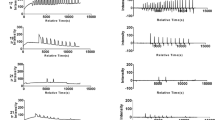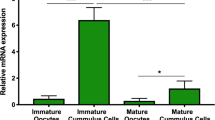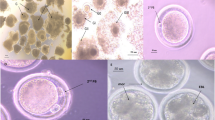Abstract
Cryopreservation of mature eggs is a useful technique that can be applied in assisted reproductive technology. However, the method has some limitations, such as cryodamage induced by biophysical modifications during the cryopreservation process. To assess these biophysical damage, we analyzed the relationship between intracellular calcium ([Ca2+]i) oscillatory activity via type 1 inositol 1,4,5-trisphosphate receptor (IP3R1) distribution after vitrification and efficiency of cryopreservation according to cryoprotectant (CPA) composition. In immunostaining, results of IP3R1with eggs after the vitrification performed using ethylene glycol (EG) alone or EG + dimethylsulfoxide (DMSO) as CPAs, CPA-treated, and fresh eggs displayed a homogeneous IP3R1 distribution which is spread uniformly throughout cytoplasm with clusters on the cortex. However, after vitrification and warming process, more than 60% of eggs displayed a heterogeneous distribution which is non-uniform distribution with patches and disconnection of IP3R1. In 90-min incubation for recovery from cryodamage, eggs from the EG + DMSO group recovered from with a heterogeneous IP3R1 distribution to the homogeneous distribution, but not in EG alone group. In ICSI experiments, vitrified eggs in the EG-alone group presented significantly low blastocyst formation compared to those of the fresh and EG + DMSO groups. These results suggest that the vitrification process influences IP3R1 distribution, and subsequently, [Ca2+]i oscillatory activity and embryonic development. Accordingly, we propose that IP3R1 distribution and [Ca2+]i oscillatory activity are correlated with egg quality and developmental potential after vitrification, and may thus be applied as an effective indicator to evaluate the efficiency of oocyte cryopreservation methods.





Similar content being viewed by others
References
Bernard A, Fuller BJ (1996) Cryopreservation of human oocytes: a review of current problems and perspectives. Hum Reprod Update 2:193–207
Bootman MD, Taylor CW, Berridge MJ (1992) The thiol reagent, thimerosal, evokes Ca2+ spikes in HeLa cells by sensitizing the inositol 1,4,5-trisphosphate receptor. J Biol Chem 267:25113–25119
Cocchia N, Ciani F, Russo M et al (2010) Immature cat oocyte vitrification in open pulled straws (OPSs) using a cryoprotectant mixture. Cryobiology 60(2):229–234
Davis FM, Tsao TY, Fowler SK, Rao PN (1983) Monoclonal antibodies to mitotic cells. Proc Natl Acad Sci USA 80:2926–2930
Ducibella T, Huneau D, Angelichio E, Xu Z, Schultz RM, Kopf GS, Fissore R, Madoux S, Ozil JP (2002) Egg-to-embryo transition is driven by differential responses to Ca(2+) oscillation number. Dev Biol 250:280–291
Fahy GM (1986) Vitrification: a new approach to organ cryopreservation. Prog Clin Biol Res 224:305–335
Fujiwara K, Sano D, Seita Y, Inomata T, Ito J, Kashiwazaki N (2010) Ethylene glycol-supplemented calcium-free media improve zona penetration of vitrified rat oocytes by sperm cells. J Reprod Dev 56:169–175
Ito J, Yoon SY, Lee B, Vanderheyden V, Vermassen E, Wojcikiewicz R, Alfandari D, De Smedt H, Parys JB, Fissore RA (2008) Inositol 1,4,5-trisphosphate receptor 1, a widespread Ca2+ channel, is a novel substrate of polo-like kinase 1 in eggs. Dev Biol 320:402–413
Jellerette T, He CL, Wu H, Parys JB, Fissore RA (2000) Down-regulation of the inositol 1,4,5-trisphosphate receptor in mouse eggs following fertilization or parthenogenetic activation. Dev Biol 223:238–250
Jellerette T, Kurokawa M, Lee B, Malcuit C, Yoon SY, Smyth J, Vermassen E, De Smedt H, Parys JB, Fissore RA (2004) Cell cycle-coupled [Ca(2+)](i) oscillations in mouse zygotes and function of the inositol 1,4,5-trisphosphate receptor-1. Dev Biol 274:94–109
Kim SH, Ku SY, Sung KC, Kang MJ, Kim SA, Kim HS, Oh SK, Jee BC, Suh CS, Choi YM, Kim JG, Moon SY (2006) Simplified EM grid vitrification is a convenient and efficient method for mouse mature oocyte cryopreservation. Yonsei Med J 47:399–404
Kline D, Kline JT (1992) Repetitive calcium transients and the role of calcium in exocytosis and cell cycle activation in the mouse egg. Dev Biol 149:80–89
Kline JT, Kline D (1994) Regulation of intracellular calcium in the mouse egg: evidence for inositol trisphosphate-induced calcium release, but not calcium-induced calcium release. Biol Reprod 50:193–203
Kline D, Mehlmann L, Fox C, Terasaki M (1999) The cortical endoplasmic reticulum (ER) of the mouse egg: localization of ER clusters in relation to the generation of repetitive calcium waves. Dev Biol 215:431–442
Laemmli UK (1970) Cleavage of structural proteins during the assembly of the head of bacteriophage T4. Nature 227:680–685
Lane M, Gardner DK (2001) Vitrification of mouse oocytes using a nylon loop. Mol Reprod Dev 58:342–347
Larman MG, Sheehan CB, Gardner DK (2006) Calcium-free vitrification reduces cryoprotectant-induced zona pellucida hardening and increases fertilization rates in mouse oocytes. Reproduction 131:53–61
Larman MG, Katz-Jaffe MG, Sheehan CB, Gardner DK (2007) 1,2-propanediol and the type of cryopreservation procedure adversely affect mouse oocyte physiology. Hum Reprod 22:250–259
Lee B, Vermassen E, Yoon SY, Vanderheyden V, Ito J, Alfandari D, De Smedt H, Parys JB, Fissore RA (2006) Phosphorylation of IP3R1 and the regulation of [Ca2+]i responses at fertilization: a role for the MAP kinase pathway. Development 133:4355–4365
Lee DR, Yang YH, Eum JH, Seo JS, Ko JJ, Chung HM, Yoon TK (2007) Effect of using slush nitrogen (SN2) on development of microsurgically manipulated vitrified/warmed mouse embryos. Hum Reprod 22:2509–2514
Lee B, Yoon SY, Malcuit C, Parys JB, Fissore RA (2010) Inositol 1,4,5-trisphosphate receptor 1 degradation in mouse eggs and impact on [Ca2+]i oscillations. J Cell Physiol 222:238–247
Lippai M, Gobet I, Tomkowiak M, Durocher Y, Leclerc C, Moreau M, Guerrier P (1995) Thimerosal triggers meiosis reinitiation in oocytes of the Japanese clam Ruditapes philippinarum by eliciting an intracellular Ca2+ surge. Int J Dev Biol 39:401–407
Lowther KM, Weitzman VN, Maier D, Mehlmann LM (2009) Maturation, fertilization, and the structure and function of the endoplasmic reticulum in cryopreserved mouse oocytes. Biol Reprod 81:147–154
Lucena E, Bernal DP, Lucena C, Rojas A, Moran A, Lucena A (2006) Successful ongoing pregnancies after vitrification of oocytes. Fertil Steril 85:108–111
Manjunatha BM, Gupta PS, Ravindra JP, Devaraj M, Nandi S (2009) Effect of vitrification medium composition and exposure time on post-thaw development of buffalo embryos produced in vitro. Vet J 179:287–291
Mann JS, Lowther KM, Mehlmann LM (2010) Reorganization of the endoplasmic reticulum and development of Ca2+ release mechanisms during meiotic maturation of human oocytes. Biol Reprod 83:578–583
Mehlmann LM, Terasaki M, Jaffe LA, Kline D (1995) Reorganization of the endoplasmic reticulum during meiotic maturation of the mouse oocyte. Dev Biol 170:607–615
Mehlmann LM, Mikoshiba K, Kline D (1996) Redistribution and increase in cortical inositol 1,4,5-trisphosphate receptors after meiotic maturation of the mouse oocyte. Dev Biol 180:489–498
Miyazaki S, Hashimoto N, Yoshimoto Y, Kishimoto T, Igusa Y, Hiramoto Y (1986) Temporal and spatial dynamics of the periodic increase in intracellular free calcium at fertilization of golden hamster eggs. Dev Biol 118:259–267
Miyazaki S, Shirakawa H, Nakada K, Honda Y (1993) Essential role of the inositol 1,4,5-trisphosphate receptor/Ca2+ release channel in Ca2+ waves and Ca2+ oscillations at fertilization of mammalian eggs. Dev Biol 158:62–78
Nagai S, Mabuchi T, Hirata S, Shoda T, Kasai T, Yokota S, Shitara H, Yonekawa H, Hoshi K (2006) Correlation of abnormal mitochondrial distribution in mouse oocytes with reduced developmental competence. Tohoku J Exp Med 210:137–144
Ozil JP, Huneau D (2001) Activation of rabbit oocytes: the impact of the Ca2+ signal regime on development. Development 128:917–928
Rogers NT, Halet G, Piao Y, Carroll J, Ko MS, Swann K (2006) The absence of a Ca(2+) signal during mouse egg activation can affect parthenogenetic preimplantation development, gene expression patterns, and blastocyst quality. Reproduction 132:45–57
Rojas C, Palomo MJ, Albarracin JL, Mogas T (2004) Vitrification of immature and in vitro matured pig oocytes: study of distribution of chromosomes, microtubules, and actin microfilaments. Cryobiology 49:211–220
Saunders CM, Larman MG, Parrington J, Cox LJ, Royse J, Blayney LM, Swann K, Lai FA (2002) PLC zeta: a sperm-specific trigger of Ca(2+) oscillations in eggs and embryo development. Development 129:3533–3544
Schultz RM, Kopf GS (1995) Molecular basis of mammalian egg activation. Curr Top Dev Biol 30:21–62
Sharma GT, Dubey PK, Chandra V (2010) Morphological changes, DNA damage and developmental competence of in vitro matured, vitrified-thawed buffalo (Bubalus bubalis) oocytes: a comparative study of two cryoprotectants and two cryodevices. Cryobiology 60:315–321
Succu S, Leoni GG, Bebbere D, Berlinguer F, Mossa F, Bogliolo L, Madeddu M, Ledda S, Naitana S (2007) Vitrification devices affect structural and molecular status of in vitro matured ovine oocytes. Mol Reprod Dev 74:1337–1344
Sun QY (2003) Cellular and molecular mechanisms leading to cortical reaction and polyspermy block in mammalian eggs. Microsc Res Tech 61:342–348
Takahashi T, Igarashi H, Doshida M, Takahashi K, Nakahara K, Tezuka N, Kurachi H (2004) Lowering intracellular and extracellular calcium contents prevents cytotoxic effects of ethylene glycol-based vitrification solution in unfertilized mouse oocytes. Mol Reprod Dev 68:250–258
Takahashi T, Igarashi H, Kawagoe J, Amita M, Hara S, Kurachi H (2009) Poor embryo development in mouse oocytes aged in vitro is associated with impaired calcium homeostasis. Biol Reprod 80:493–502
Tan X, Song E, Liu X, You W, Wan F (2009) Factors affecting the survival, fertilization, and embryonic development of mouse oocytes after vitrification using glass capillaries. In Vitro Cell Dev Biol Anim 45:420–429
Westendorf JM, Rao PN, Gerace L (1994) Cloning of cDNAs for M-phase phosphoproteins recognized by the MPM2 monoclonal antibody and determination of the phosphorylated epitope. Proc Natl Acad Sci USA 91:714–718
Wojcikiewicz RJ, Tobin AB, Nahorski SR (1994) Muscarinic receptor-mediated inositol 1,4,5-trisphosphate formation in SH-SY5Y neuroblastoma cells is regulated acutely by cytosolic Ca2+ and by rapid desensitization. J Neurochem 63:177–185
Yamada C, Caetano HV, Simoes R, Nicacio AC, Feitosa WB, Assumpcao ME, Visintin JA (2007) Immature bovine oocyte cryopreservation: comparison of different associations with ethylene glycol, glycerol and dimethylsulfoxide. Anim Reprod Sci 99:384–388
Yoon TK, Lee DR, Cha SK, Chung HM, Lee WS, Cha KY (2007) Survival rate of human oocytes and pregnancy outcome after vitrification using slush nitrogen in assisted reproductive technologies. Fertil Steril 88:952–956
Yoon SY, Jellerette T, Salicioni AM, Lee HC, Yoo MS, Coward K, Parrington J, Grow D, Cibelli JB, Visconti PE, Mager J, Fissore RA (2008) Human sperm devoid of PLC, zeta 1 fail to induce Ca(2+) release and are unable to initiate the first step of embryo development. J Clin Invest 118:3671–3681
Yoshida N, Perry AC (2007) Piezo-actuated mouse intracytoplasmic sperm injection (ICSI). Nat Protoc 2:296–304
Zhang D, Pan L, Yang LH, He XK, Huang XY, Sun FZ (2005) Strontium promotes calcium oscillations in mouse meiotic oocytes and early embryos through InsP3 receptors, and requires activation of phospholipase and the synergistic action of InsP3. Hum Reprod 20:3053–3061
Zhao XM, Fu XW, Hou YP, Yan CL, Suo L, Wang YP, Zhu HB, Dinnyes A, Zhu SE (2009) Effect of vitrification on mitochondrial distribution and membrane potential in mouse two pronuclear (2-PN) embryos. Mol Reprod Dev 76:1056–1063
Acknowledgement of financial support
This work was supported by a grant from the Korea Healthcare Technology R&D Project, Ministry for Health, Welfare & Family affairs, Republic of Korea (A084923).
Author information
Authors and Affiliations
Corresponding authors
Additional information
Bo Yeun Kim and Sook-Young Yoon equally contributed to this work.
Capsule
Calcium oscillatory activity changes as an indicator of development of embryos derived from vitrified eggs
Rights and permissions
About this article
Cite this article
Kim, B.Y., Yoon, SY., Cha, S.K. et al. Alterations in calcium oscillatory activity in vitrified mouse eggs impact on egg quality and subsequent embryonic development. Pflugers Arch - Eur J Physiol 461, 515–526 (2011). https://doi.org/10.1007/s00424-011-0955-0
Received:
Revised:
Accepted:
Published:
Issue Date:
DOI: https://doi.org/10.1007/s00424-011-0955-0




